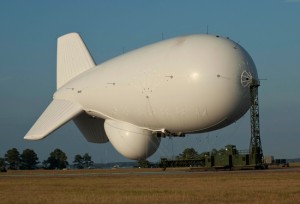Aerostats as swarming boat spotters
A time honored strategy for reinvigorating a defense project in Congress is to tie it to an issue on the minds of lawmakers.
That's Raytheon's strategy for saving its radar-equipped JLENS aerostats, known formally as Joint Land Attack Cruise Missile Defense Elevated Netted Sensor systems.
Unless Congress or the Pentagon's acquisition chief steps in, the Army will wrap up all of its JLENS work in 2014, aside from a possible "Combatant Command Exercise" somewhere in the U.S. before 2017. Even that exercise looks problematic, with Senate appropriators balking at paying $30.5 million in 2013 toward it. The project could end with just four aerostats, no real world test and $2 billion expended.
Raytheon hasn't given up hope for continuing into production with JLENS, which is where the issue on the minds of lawmakers comes in.
As the term "cruise missile" in the name suggests, the Army kicked off the JLENS project in 2006 mainly to show how radars could stare down from aerostats and track terrain-hugging missiles, helicopters and small planes.
With lawmakers flocking back to town and tensions simmering with Iran, Raytheon is pointing to JLENS as part of the answer to the worry that small boats could swarm around U.S. warships, particularly at strategic choke points.
If you were to guess that means the Strait of Hormuz, Mark Rose's eyes will widen and you'll be pretty sure you detect a nod. Rose, a 32-year Raytheon employee, directs the company's JLENS work.
"Swarming boats have been in the plan all along, but it's receiving more urgency now given the threat sets in the world," he tells Deep Dive.
In June, Raytheon laid the groundwork for the case by motoring two small inflatable boats over Utah's Great Salt Lake. It wasn't a swarm, but it was good enough to test JLENS' ability to track small boats in motion. JLENS has tracked large numbers of cars on distant highways, which makes Raytheon confident the aerostats can handle lots of boats too.
Swarm conjures images of boats racing toward U.S. ships, but actually the bigger challenge for a Doppler radar is to track slow moving things. JLENS did better than specifications when engineers tested how slowly they could move the boats and still keep track of them, an Army official says.
At the moment, there are no plans to send JLENS to any distant hot spots, which is not to say that hasn't been considered. There was a plan to send JLENS to someplace in the Central Command area but the idea was shelved more than a year ago out of concern that the deployment could be seen as provocative.
"It's a pretty big step when you put a football field-length airship up in that region," the Army official says.
In Congress, Raytheon could be onto something with its new focus on swarming boats. House authorizers, for instance, want the Navy to field a 100 to 200 kilowatt laser to defend ships against drones, cruise missiles and also "fast attack craft threats."
"The beauty of this system is that you can see things from so far away that you have lots of time to make decisions," Rose says. Plus, by flying for 30 days at a time, JLENS could also map patterns of life on land and sea, he adds.
Each system consists of two, 74-meter-long aerostats. One is equipped with a VHF-radar for surveillance. The other carries an X-band fire control radar for locking weapons onto targets. The radar readings are sent to the ground via fiber optic cables protected inside each aerostat's Kevlar-reinforced tether. Operators feed them into networks, including the Navy's Cooperative Engagement Capability network.
JLENS is designed to detect and track small aircraft, boats or trucks out to a range of 512 kilometers.
Rose says that if he had his druthers, the Pentagon would send a JLENS to a location where it could track objects both on land and at sea. Ultimately, Raytheon hopes the Pentagon will reverse course and issue a production contract.
If that happens, JLENS will have bucked a troubled history. In December 2010, the Pentagon reported that its unit cost had risen 17.88 percent, which amounted to a "significant breach" of the Nunn-McCurdy cost control law. One factor was bad luck. In September, a JLENS was riding out a tropical storm on the ground in Elizabeth City, N.C., when another aerostat crashed into it, seriously injuring a worker and damaging the JLENS beyond repair. Elizabeth City is the manufacturing hub of TCOM, the lighter-than-air specialists who made the JLENS hulls for Raytheon.
Bad luck, shifting Army priorities and radar development delays prompted the Pentagon to scrap plans to purchase 16 JLENS systems. The decision left just the two systems now in the inventory, which equates to four aerostats. The reduced buy sent projected unit costs upwards and triggered a full-on Nunn-McCurdy breach that required the Pentagon to recertify the program to Congress. The recertification has had limited impact so far. The Pentagon continues to plan for the exercise but has no plans at the moment to procure more of the aerostats.
Rose says Raytheon has figured out how to cut production costs by incorporating components from the company's contributions to the anti-missile Terminal High Altitude Area Defense system, or THAAD, which spots missiles and knocks them down high in the atmosphere. "We've been able to reduce the cost 30 percent by recognizing the commonalities," Rose says. The strategy allows Raytheon to negotiate higher volume purchasing agreements with component suppliers.



